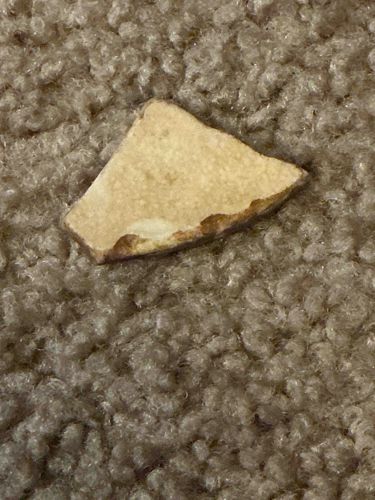
Ceramic Shard (Pottery Fragment)
This item is a ceramic shard, a fragment of what was once a larger piece of pottery. It presents as a somewhat irregularly shaped, roughly triangular fragment. The visible surface color is a muted, pale yellow or cream, suggesting an earthenware or stoneware body that might have been glazed, although the highly worn condition makes a definitive determination difficult. The 'additional context' suggests it was found in Lake Superior, which strongly implies significant exposure to water and abrasive elements. This is consistent with the current condition of the shard; all edges are heavily worn and smoothed, lacking any sharp breaks. The underside or fracture surface, particularly along the bottom edge, reveals a darker, reddish-brown coloration, which is likely the raw clay body. This contrast suggests the presence of a slip or glaze on the lighter surface. There are no discernible patterns, decorations, or maker's marks visible on the fragment. Its diminutive size and the extent of its abrasion indicate a substantial period of weathering and tumbling. The quality of the original pottery cannot be fully assessed from this small fragment due to its heavily damaged state, but the presence of a distinct clay body color beneath a lighter surface suggests it was likely a functional piece of utilitarian pottery. Without clearer markings or decorative elements, it is difficult to assign a precise style period or estimated age, but its presence in a large body of water like Lake Superior suggests it could potentially be historical, perhaps originating from shipwreck debris or shore refuse from past centuries.
AI-Generated Appraisal Disclaimer
Estimated Value
$5 - $15
Basic Information
Category
Ceramic Fragment
Appraised On
November 22, 2025
Estimated Value
$5 - $15
Additional Details Provided By Owner
User Provided Information
Piece of Pottery found in Lake Superior
Item Description
This item is a ceramic shard, a fragment of what was once a larger piece of pottery. It presents as a somewhat irregularly shaped, roughly triangular fragment. The visible surface color is a muted, pale yellow or cream, suggesting an earthenware or stoneware body that might have been glazed, although the highly worn condition makes a definitive determination difficult. The 'additional context' suggests it was found in Lake Superior, which strongly implies significant exposure to water and abrasive elements. This is consistent with the current condition of the shard; all edges are heavily worn and smoothed, lacking any sharp breaks. The underside or fracture surface, particularly along the bottom edge, reveals a darker, reddish-brown coloration, which is likely the raw clay body. This contrast suggests the presence of a slip or glaze on the lighter surface. There are no discernible patterns, decorations, or maker's marks visible on the fragment. Its diminutive size and the extent of its abrasion indicate a substantial period of weathering and tumbling. The quality of the original pottery cannot be fully assessed from this small fragment due to its heavily damaged state, but the presence of a distinct clay body color beneath a lighter surface suggests it was likely a functional piece of utilitarian pottery. Without clearer markings or decorative elements, it is difficult to assign a precise style period or estimated age, but its presence in a large body of water like Lake Superior suggests it could potentially be historical, perhaps originating from shipwreck debris or shore refuse from past centuries.
Get Your Items Appraised
Instant estimates of your treasures with AI-powered instant appraisals